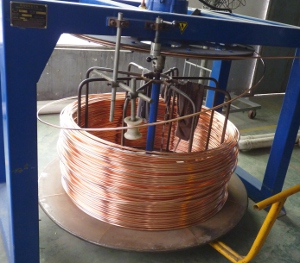Posted 06 June 2019

CCA, CCS, CCC vs. pure copper – know the difference?
Copper can be up to 80% of the cost of a cable so it’s no surprise then that alternatives to copper are constantly being sought. The practice of substituting solid copper with copper clad aluminium (CCA) or copper clad steel (CCS) to save money is still commonplace, so, do you know what the differences could mean to you?
What is CCA?
The most common alternative to copper used in the electrical industry is aluminium. Widely used in power distribution, many aluminium cables are buried under the road as power cables. CCA is an aluminium conductor with a thin copper coating. It’s made by encasing a rod of aluminium in a layer of copper strip which is butt-welded along the seam to totally encase the aluminium. The entire rod is drawn through a series of rollers and dies to reduce the diameter to as little as 0.1mm, just over the thickness of a human hair. The main disadvantages are its lack of flexibility, higher resistance and lower conductivity compared with copper. This means you have to use more of it to carry the same current or amps. In a power cable this is not normally a problem as you only have to go up a size or two. It results in a bigger overall cable using more insulation, sheathing and armouring, but the savings made over an equivalent copper cable are considerable. Aluminium is also used in some high frequency coaxial cables where aluminium can perform better than copper at very high frequencies (GHz). In both these cases the aluminium is bare (silvery in colour) and is easily spotted. It is not being disguised to look like copper.

CCA does have some advantages over solid copper, mainly surrounding weight and cost. CCA is significantly lighter than copper and in some applications can offer advantages in cable containment and handling. Aluminium is around a third of the price of copper and therefore provides cost savings over solid copper conductors. Theft is also less likely with scrap values largely reduced. It also has better corrosion resistance over plain aluminium.
What is CCS?
CCS (copper clad steel) is similar to CCA in that a steel conductor is thinly coated with a layer of copper. Steel gives higher mechanical strength than aluminium but is heavier and less flexible. It is of course also less conductive than copper. It’s manufactured in the same way as CCA, whereby the applied copper is drawn down to smaller diameters through rollers and dies.

What is CCC?

Another significant problem is the use of recycled copper as a conductor material. Known as CCC (Copper Clad Copper), these conductors use low grade copper alloys made from mixing recycled copper with impurities such as brass, tin and other contaminants and forming them into 8mm rod. This is then clad in copper foil and reduced using the same process as CCA resulting in a conductor full of impurities with a very high oxygen content and resistance that may be even higher than aluminium. This can be very difficult to spot as the conductor looks ‘yellow-ish’ (much like copper when cut through). The best way to check is to measure the resistance of the conductor if you have the right equipment.
Which cables are affected?
The cables that are mainly affected are internal telephone cables - CW1308 style, alarm cables and coaxes. Some manufacturers are also offering Cat 5 and other data cables as CCA.
What are the hazards associated with CCA and CCS?
The main problems are that aluminium and steel have a much higher resistance than copper. This leads to a decrease in current capacity resulting in the cable overheating and potentially leading to a fire. Aluminium is also far more brittle than copper and this can lead to breakages during installation.
These cables are also prone to fatigue at the point of termination which can cause random faults. This is particularly true with insulation displacement connectors (ICD). Alarm systems using CCA could lead to false readings and false alarms whilst with coaxes it leads to degradation of picture quality, particularly over long distances.
Why this is a problem?
One of the difficulties is that even on close inspection it can be very difficult to spot CCA. As the cable is cut there is a tendency for the copper to smudge over the cut end of the aluminium making it look like solid copper. Sometimes it’s possible to tell with a magnifying glass or a simple burn test using a cigarette lighter. Aluminium has a higher melting point than that of copper for example.
CCA must not be simply dismissed out of hand however. Some applications, short runs for example, CCA could well work to an acceptable standard. In this case make sure you are aware of what you are buying and are receiving a significant cost saving. In some applications the savings may be worthwhile whereas on others, the return visits and customer dissatisfaction will be too great.
Conclusion
Talk to your supplier and make sure you are aware of what is being supplied. Resistance may not be a problem over short runs. In some cases the cost saving can be attractive but make sure you have considered the application and what the installation is intended to achieve. If like most users, you want to simply ‘install and forget’ you may be better to stick with pure copper conductors and benefit from their proper performance characteristics. Check the standard that the cable should meet, if pure copper is specified its been done for a reason, in which case you need to question if substituting CCA or CCS is a good idea.
Some suppliers clearly state CCA or CCS in their description but if in doubt ask for a technical datasheet. If you are being offered cheap cable you should be cautious. You should be very careful if the description or spec sheet mentions CCA, CCS or Copper Alloy. Whichever you choose make sure you are aware of what you are buying – solid copper, copper covered aluminium or copper clad steel. There is a big difference.





